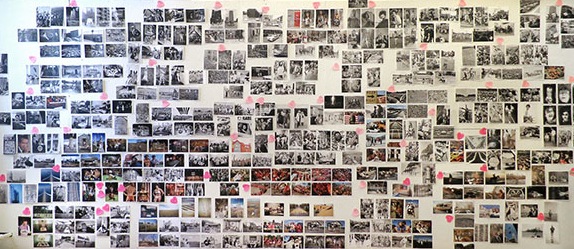More Press Coverage for Photographer’s Paradise!
More Press Coverage for Photographer’s Paradise!
It’s not all grit, however. He worked nearly as much in color as in black-and-white, which was still a little unusual for serious photographers back then. In that regard, Laffont cites the Magnum photographer Ernst Haas as his chief influence. “He was doing something totally different — taking pictures in color, of the time, straight traditional horizons, good composition.”
Speaking of which, you can see in this book Laffont’s particular taste for a kind of photo that is very much of the moment today: a field of edge-to-edge pattern, with a small device that repeats throughout the frame. – New York magazine
Whenever possible, he wandered the streets of New York following his curiosity and making pictures. He encountered his fellow New Yorkers with enthusiasm and respect, and they embraced him.
It was unlike anywhere else he had photographed. – NY Times
These photo books, lovingly designed and meticulously edited, are a rare treat in a time when photography is all-too-often relegated to selfies and snapshots, and offer an opportunity to truly indulge in the unfettered beauty of a well-made book. – Time Magazine
“Some of Laffont’s best work is now showcased in a new book titled ‘Photographer’s Paradise: Turbulent America 1960-1990’ -published by Glitterati Incorporated. “ The Daily Mail
Sixties America was far from a paradise but, says Laffont, it was a dream place to be a photographer. “It was really visual,” he says, “and it was extremely simple to photograph the city’s problems at that time.” The Telegraph
“Ku Klux Klan rallies in LA, Muhammad Ali sounding off, and the kissing competition at the first Gay Pride in New York … Jean-Pierre Laffont captured it all.” –The Guardian
“Dans le livre “Le paradis d’un photographe” défilent trente années d’histoire américaine vues à travers le regard d’un frenchie passionné par le bouillonnement social et culturel de son pays d’adoption. Jean-Pierre Laffont, photojournaliste reconnu et ancien membre fondateur des agences Gamma USA et Sygma, a puisé dans ses archives pour nous restituer en près de 350 images allant de 1960 à 1990 toute la diversité et les turbulences d’une époque : du mouvement pour les droits civiques, à la chaise électrique de Sing Sing, des funérailles de Robert F. Kennedy aux villages des hippies, en passant par les personnalités en vue et l’air du temps.” –TempsReel
“It hardly seems possible that one individual could have photographed all these and so many other stories—much less captured them with such conviction, insight and empathy. Moreover, the issues and the implications in Laffont’s photographs retain their relevance, as he notes in the book’s introduction” –Black & White
“The reality is that Jean-Pierre Laffont has seen things. Yes, he is one of the most celebrated photojournalists in history, not to mention the founding member of one of the world’s biggest photo agencies (Gamma USA and Sygma Photo News). But strip back the acclaim and the career and you’ve got a man who’s had a front row seat to some of the most seismic moments in American history.
After sitting in archives for years, Laffont work is finally on the page. Photographer’s Paradise: Turbulent America 1960-1990 materialises as more than Laffont’s story, more than those he captured. It’s a tribute to the human condition. And when it gets down to it, it’s proof of what can happen when you ditch the wall and actually see.” –Hero Magazine
“Even if you are familiar with the best photojournalism of that time, Laffont’s eye for the surreal and the surprising is almost uncanny.” –The Guardian
Photojournalist Jean-Pierre Laffont devoted his life to recording the most important world events for close to 55 years. He is not only a savvy photographer with a camera in his hand at all the right times but a businessman who founded the U.S. bureau of Gamma Agency with his wife.- The Advocate
“Man Ray once said, “A good photograph is one that communicates a fact, touches the heart and leaves the viewer a changed person for having seen it. It is, in a word, effective,” which is what photojournalist Pierre Laffont’s pictures are all about” – Cause and Yvette
“[I]n the US, one man was taking it all in; documenting a culture and lifestyle of an era that changed us all…free love and free spirits…from civil rights to women’s rights and politics to personalities. Jean-Pierre Laffont was enjoying the freedom given to photographers back then in what he called a, ‘Photographer’s Paradise,'”- zPhotoJournal
And Early Praise for JP’s Newest Book: New York City Up And Down!
“Laffont and his camera seemed to be here, there and everywhere all at one, capturing an indelible visual record of Balzacian dimensions. What sets his photographs apart is his eye for detail, his knack for choosing the right perspective for maxim clarity and effect, his command of moments both big and small, and his fearless yet always respectful interaction with the people in front of his camera.” – Black & White
“Seen together in a pair of recent monographs, the Frenchman’s oeuvre is a pastiche of flags, crowds, and other politically loaded symbols of American innocence and vulgarity. Laffont’s extended photo essays on inner-city youth gangs, a failed rock festival in Connecticut, pet cemeteries, and a nefarious Oregon cult reveal a fragmented society at once marked by optimism and paralyzed by disappointment.”- Timeline

